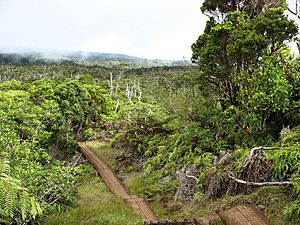Hawaiian tropical rainforests facts for kids
Quick facts for kids Hawaiian tropical rainforests |
|
|---|---|

|
|
| Ecology | |
| Realm | Oceanian |
| Biome | Tropical and subtropical moist broadleaf forests |
| Borders | Hawaiian tropical dry forests and Hawaiian tropical high shrublands |
| Geography | |
| Area | 6,700 km2 (2,600 sq mi) |
| Country | United States |
| State | Hawaii |
| Conservation | |
| Conservation status | Critical/Endangered |
| Global 200 | Yes |
The Hawaiian Jungles are amazing rainforests found on the Hawaiian Islands. They cover about 6,700 square kilometers (2,587 square miles). You can find them in the wet, low-lying areas and high up in the mountains.
These forests grow at different heights. Some are near the coast, others are mixed forests higher up, and some are very wet forests even higher. There are also wet bogs and shrublands on mountain tops.
For 28 million years, the Hawaiian Islands have been far away from other lands. This isolation has helped many unique plants and animals grow here. You can find special fungi, mosses, snails, birds, and other wildlife. In the lush, wet mountain forests, trees are covered with vines, orchids, ferns, and mosses. One of the wettest places on Earth is here. The slopes of Mount Waiʻaleʻale get about 9,474 mm (373 inches) of rain each year!
Contents
Coastal Mesic Forests: Where Land Meets Sea
Coastal mesic forests grow on the wet, windy sides of the main islands. They are found from sea level up to about 300 meters (980 feet) high. For the last 1,000 to 2,000 years, these forests have been home to native hala (Pandanus tectorius) and hau (Hibiscus tiliaceus) trees.
Other common trees here are kukui (Aleurites molucana) and milo (Thespesia populnea). These were brought to Hawaii by early Polynesian settlers. You might also see noni (Morinda citrifolia), pia (Tacca leontopetaloides), and kī (Cordyline fruticosa). Native plants like pololei (Ophioglossum concinnum), ʻākia (Wikstroemia species), and loulu fan palms (Pritchardia species) also live here. Look for ʻōhiʻa lehua (Metrosideros polymorpha) and lama (Diospyros sandwicensis) trees too.
Mixed Mesic Forests: A Blend of Trees
Mixed mesic forests are found on the windy slopes of the larger islands. They are usually between 750 to 1,250 meters (2,460 to 4,100 feet) high. The top of Mount Lānaʻihale on Lānaʻi also has these forests. They get 1,000 to 2,500 mm (39 to 98 inches) of rain each year. This means they might not be true rainforests.
The top layer of trees, called the canopy, is mostly koa (Acacia koa) and ʻōhiʻa lehua (Metrosideros polymorpha). The canopy is a bit open, but there are many trees. Other trees and shrubs include pāpala (Charpentiera obovata), olopua (Nestegis sandwicensis), and hame (Antidesma platyphyllum). You can also find mēhame (Antidesma pulvinatum), kōpiko (Psychotria mariniana), and ʻōpiko (Psychotria mauiensis).
Other plants in these forests are ʻiliahi (Santalum freycinetianum), hōlei (Ochrosia species), and poʻolā (Claoxylon sandwicense). Look for kōlea lau nui (Myrsine lessertiana), kauila (Alphitonia ponderosa), and nioi (Eugenia reinwardtiana). You might also spot aʻiaʻi (Streblus pendulinus) and hōʻawa (Pittosporum species).
Wet Forests: Lush and Rainy Homes
Wet forests usually grow from 1,250 to 1,700 meters (4,100 to 5,580 feet) high. But sometimes they can be as low as 200 meters (660 feet). These forests get a lot of rain, from 3,000 to 11,250 mm (118 to 443 inches) per year.
The main tree in the canopy is ʻōhiʻa lehua (Metrosideros polymorpha). Koa (Acacia koa) trees are also very common here. Other trees include kāwaʻu (Ilex anomala), ʻalani (Melicope clusiifolia), and ʻōhiʻa ha (Syzygium sandwicensis). You can also find kōlea lau nui (Myrsine lessertiana), ʻohe (Tetraplasandra species), and olomea (Perrottetia sandwicensis). Hāpuʻu (Cibotium tree ferns) are also common.
The plants growing under the main trees, called the understory, include ʻapeʻape (Gunnera petaloidea), ʻoha wai (Clermontia species), and hāhā (Cyanea species). You can also see kāmakahala (Labordia hirtella), kanawao (Broussaisia arguta), Phyllostegia species, and ʻākala (Rubus hawaiensis). Other understory plants are kāmanamana (Adenostemma lavenia), Pilea peploides, māmaki (Pipturus albidus), olonā (Touchardia latifolia), and ʻalaʻala wai nui (Peperomia species).
Vines like maile (Alyxia oliviformis) and hoi kuahiwi (Smilax melastomifolia) grow here. Some plants grow on other plants, these are called epiphytes. ʻIeʻi.e. (Freycinetia arborea), puaʻakuhinia (Astelia menziesiana), and ʻōlapa (Cheirodendron trigynum) are epiphytic flowering plants. Epiphytic ferns, such as Adenophorus species, ohiaku (Hymenophyllum recurvum), and Ophioglossum pendulum, cover trees. ʻĀkaha (Asplenium nidus), ʻēkaha (Elaphoglossum hirtum), and makue lau lii (Grammitis hookeri) are also epiphytic ferns. Epiphytic mosses like Acroporium fuscoflavum, Rhizogonium spiniforme, and Macromitrium owahiense are common. Loulu fan palms (Pritchardia species) can grow taller than the forest canopy.
Bogs: Wet and Unique Habitats
Bogs are found in mountain areas where there is more rainfall than the ground can drain. The main plants in bogs are shrubs, sedges, and grasses. Larger shrubs and small trees grow around the edges of the bogs or on raised mounds.
Common sedges include Carex species, Oreobolus furcatus, and Rhynchospora rugosa. Shrubs you might see are ʻōhelo kau laʻau (Vaccinium calycinum) and ʻōhelo (Vaccinium dentatum). Grasses found here are Dichanthelium species and Deschampsia nubigena.
Small varieties of ʻōhiʻa lehua (Metrosideros polymorpha vars. incana and glabriofolia) are the most common trees at the edges of bogs. The ferns wāwaeʻiole (Lycopodiella cernua), ʻamaʻu (Sadleria species), and uluhe (Dicranopteris linearis) also grow in bogs. Some rare plants found here are liliwai (Acaena exigua), naʻenaʻe (Dubautia species), and Argyroxiphium species.
Images for kids


